Numeracy, Data, and IT: Applying Statistical Concepts and IT Skills
VerifiedAdded on 2023/06/18
|22
|3649
|98
Homework Assignment
AI Summary
This assignment solution focuses on applying numeracy, data analysis, and IT skills to solve statistical problems. It covers basic numerical operations, fractions, integers, and decimals, including calculating proportions, averages, and percentages. The report interprets data presented in graphs and uses spreadsheet applications to record and analyze numerical data. Specific questions address fraction simplification, percentage calculations related to library books and discounts, and power of 10 representations. The solution also analyzes Olympic medal data, determining modes, ranges, and comparative performance across countries, and it uses Excel functions to rank data and identify countries meeting specific medal criteria. The analysis extends to discussing factors affecting a country's Olympic performance and comparing medal achievements.
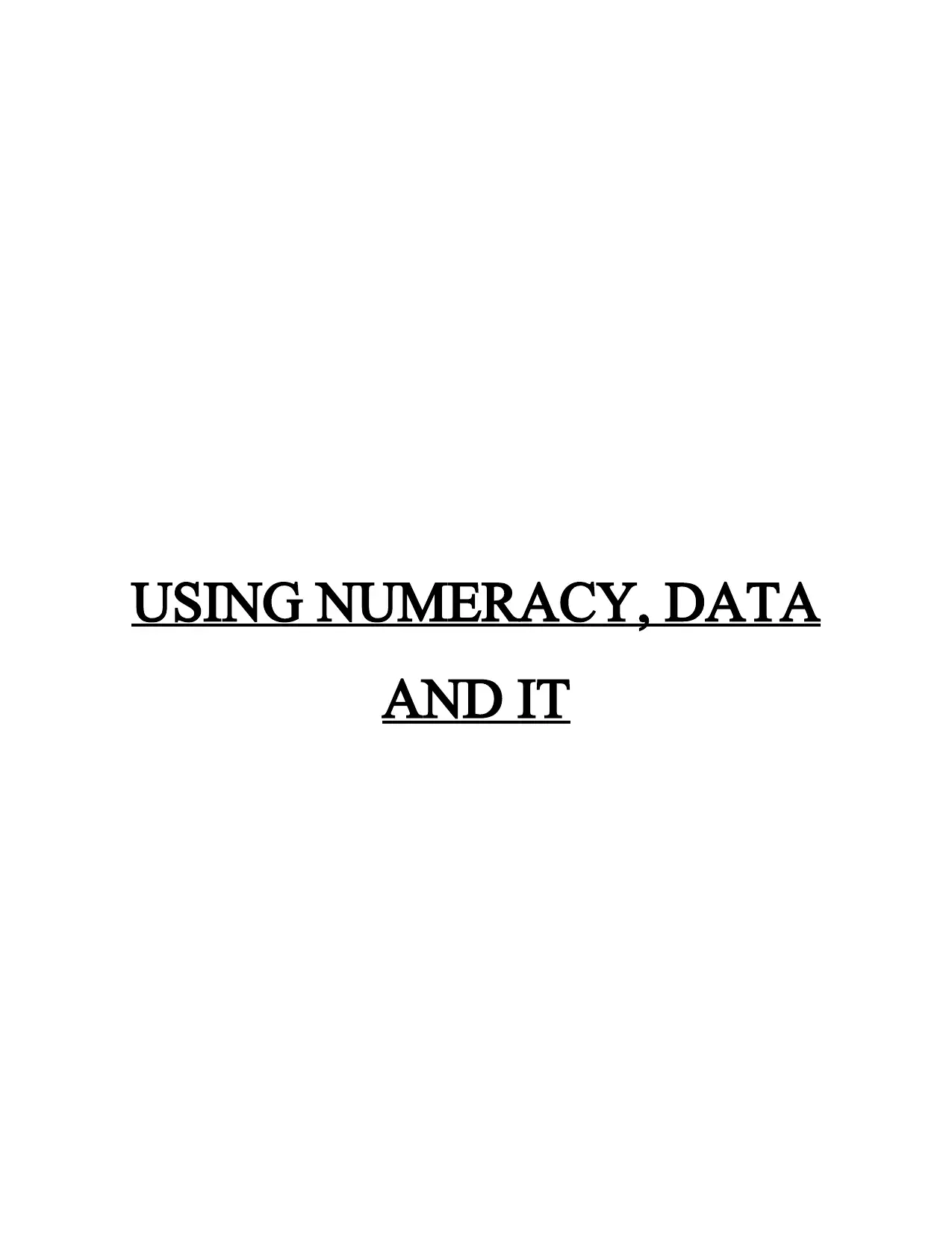
USING NUMERACY, DATA
AND IT
AND IT
Paraphrase This Document
Need a fresh take? Get an instant paraphrase of this document with our AI Paraphraser
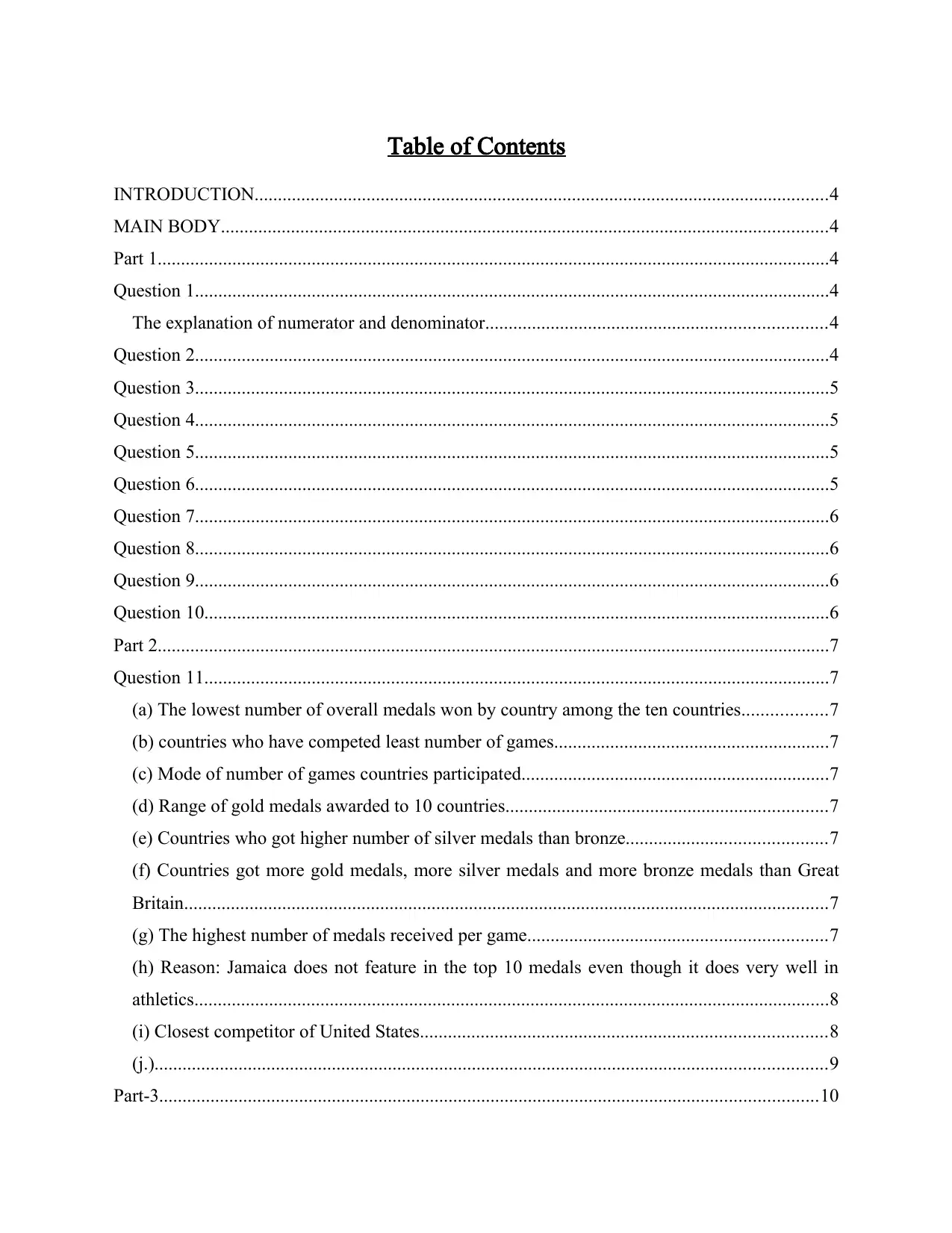
Table of Contents
INTRODUCTION...........................................................................................................................4
MAIN BODY..................................................................................................................................4
Part 1................................................................................................................................................4
Question 1........................................................................................................................................4
The explanation of numerator and denominator.........................................................................4
Question 2........................................................................................................................................4
Question 3........................................................................................................................................5
Question 4........................................................................................................................................5
Question 5........................................................................................................................................5
Question 6........................................................................................................................................5
Question 7........................................................................................................................................6
Question 8........................................................................................................................................6
Question 9........................................................................................................................................6
Question 10......................................................................................................................................6
Part 2................................................................................................................................................7
Question 11......................................................................................................................................7
(a) The lowest number of overall medals won by country among the ten countries..................7
(b) countries who have competed least number of games...........................................................7
(c) Mode of number of games countries participated..................................................................7
(d) Range of gold medals awarded to 10 countries.....................................................................7
(e) Countries who got higher number of silver medals than bronze...........................................7
(f) Countries got more gold medals, more silver medals and more bronze medals than Great
Britain..........................................................................................................................................7
(g) The highest number of medals received per game................................................................7
(h) Reason: Jamaica does not feature in the top 10 medals even though it does very well in
athletics........................................................................................................................................8
(i) Closest competitor of United States.......................................................................................8
(j.)................................................................................................................................................9
Part-3.............................................................................................................................................10
INTRODUCTION...........................................................................................................................4
MAIN BODY..................................................................................................................................4
Part 1................................................................................................................................................4
Question 1........................................................................................................................................4
The explanation of numerator and denominator.........................................................................4
Question 2........................................................................................................................................4
Question 3........................................................................................................................................5
Question 4........................................................................................................................................5
Question 5........................................................................................................................................5
Question 6........................................................................................................................................5
Question 7........................................................................................................................................6
Question 8........................................................................................................................................6
Question 9........................................................................................................................................6
Question 10......................................................................................................................................6
Part 2................................................................................................................................................7
Question 11......................................................................................................................................7
(a) The lowest number of overall medals won by country among the ten countries..................7
(b) countries who have competed least number of games...........................................................7
(c) Mode of number of games countries participated..................................................................7
(d) Range of gold medals awarded to 10 countries.....................................................................7
(e) Countries who got higher number of silver medals than bronze...........................................7
(f) Countries got more gold medals, more silver medals and more bronze medals than Great
Britain..........................................................................................................................................7
(g) The highest number of medals received per game................................................................7
(h) Reason: Jamaica does not feature in the top 10 medals even though it does very well in
athletics........................................................................................................................................8
(i) Closest competitor of United States.......................................................................................8
(j.)................................................................................................................................................9
Part-3.............................................................................................................................................10
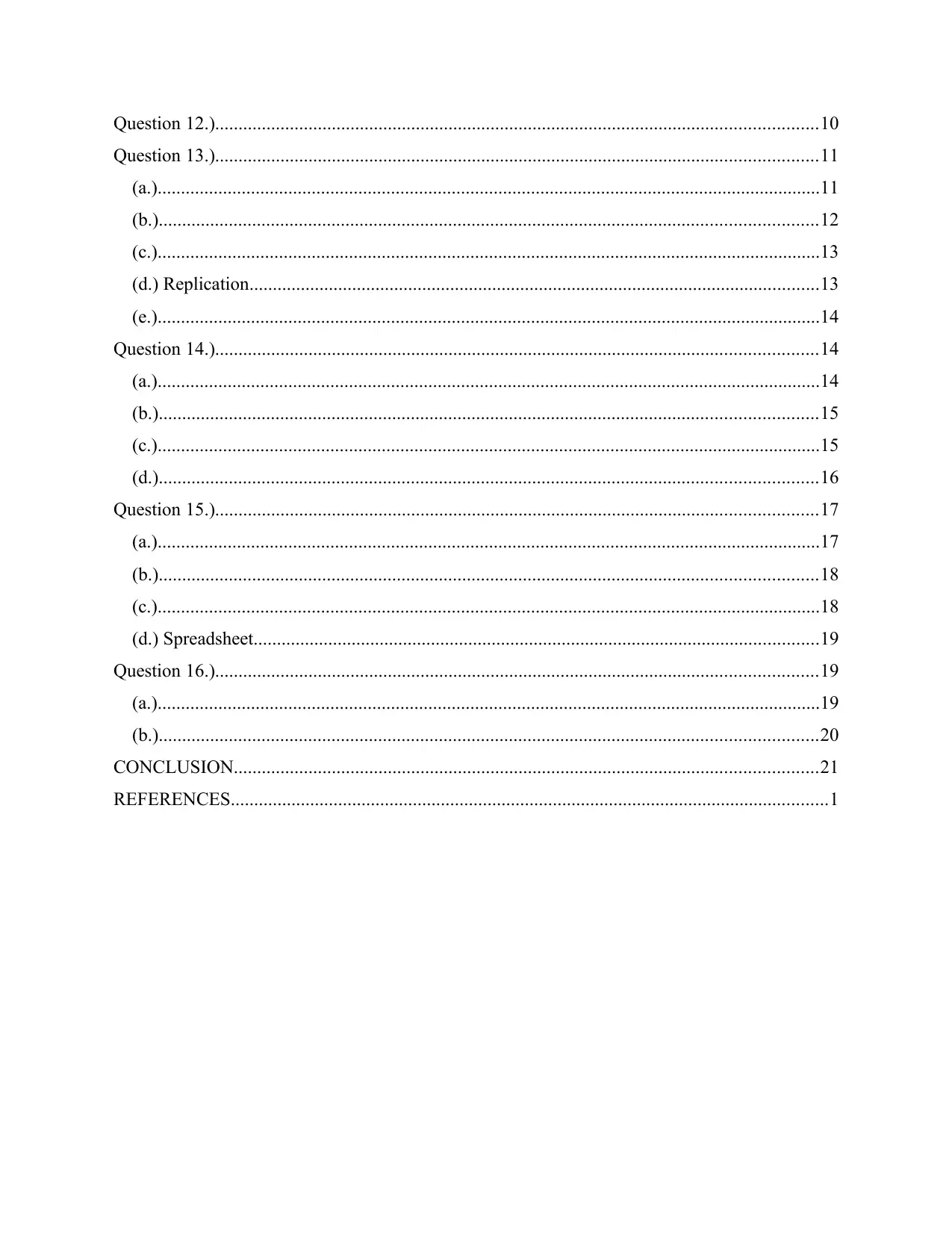
Question 12.).................................................................................................................................10
Question 13.).................................................................................................................................11
(a.)..............................................................................................................................................11
(b.).............................................................................................................................................12
(c.)..............................................................................................................................................13
(d.) Replication..........................................................................................................................13
(e.)..............................................................................................................................................14
Question 14.).................................................................................................................................14
(a.)..............................................................................................................................................14
(b.).............................................................................................................................................15
(c.)..............................................................................................................................................15
(d.).............................................................................................................................................16
Question 15.).................................................................................................................................17
(a.)..............................................................................................................................................17
(b.).............................................................................................................................................18
(c.)..............................................................................................................................................18
(d.) Spreadsheet.........................................................................................................................19
Question 16.).................................................................................................................................19
(a.)..............................................................................................................................................19
(b.).............................................................................................................................................20
CONCLUSION.............................................................................................................................21
REFERENCES................................................................................................................................1
Question 13.).................................................................................................................................11
(a.)..............................................................................................................................................11
(b.).............................................................................................................................................12
(c.)..............................................................................................................................................13
(d.) Replication..........................................................................................................................13
(e.)..............................................................................................................................................14
Question 14.).................................................................................................................................14
(a.)..............................................................................................................................................14
(b.).............................................................................................................................................15
(c.)..............................................................................................................................................15
(d.).............................................................................................................................................16
Question 15.).................................................................................................................................17
(a.)..............................................................................................................................................17
(b.).............................................................................................................................................18
(c.)..............................................................................................................................................18
(d.) Spreadsheet.........................................................................................................................19
Question 16.).................................................................................................................................19
(a.)..............................................................................................................................................19
(b.).............................................................................................................................................20
CONCLUSION.............................................................................................................................21
REFERENCES................................................................................................................................1
⊘ This is a preview!⊘
Do you want full access?
Subscribe today to unlock all pages.

Trusted by 1+ million students worldwide
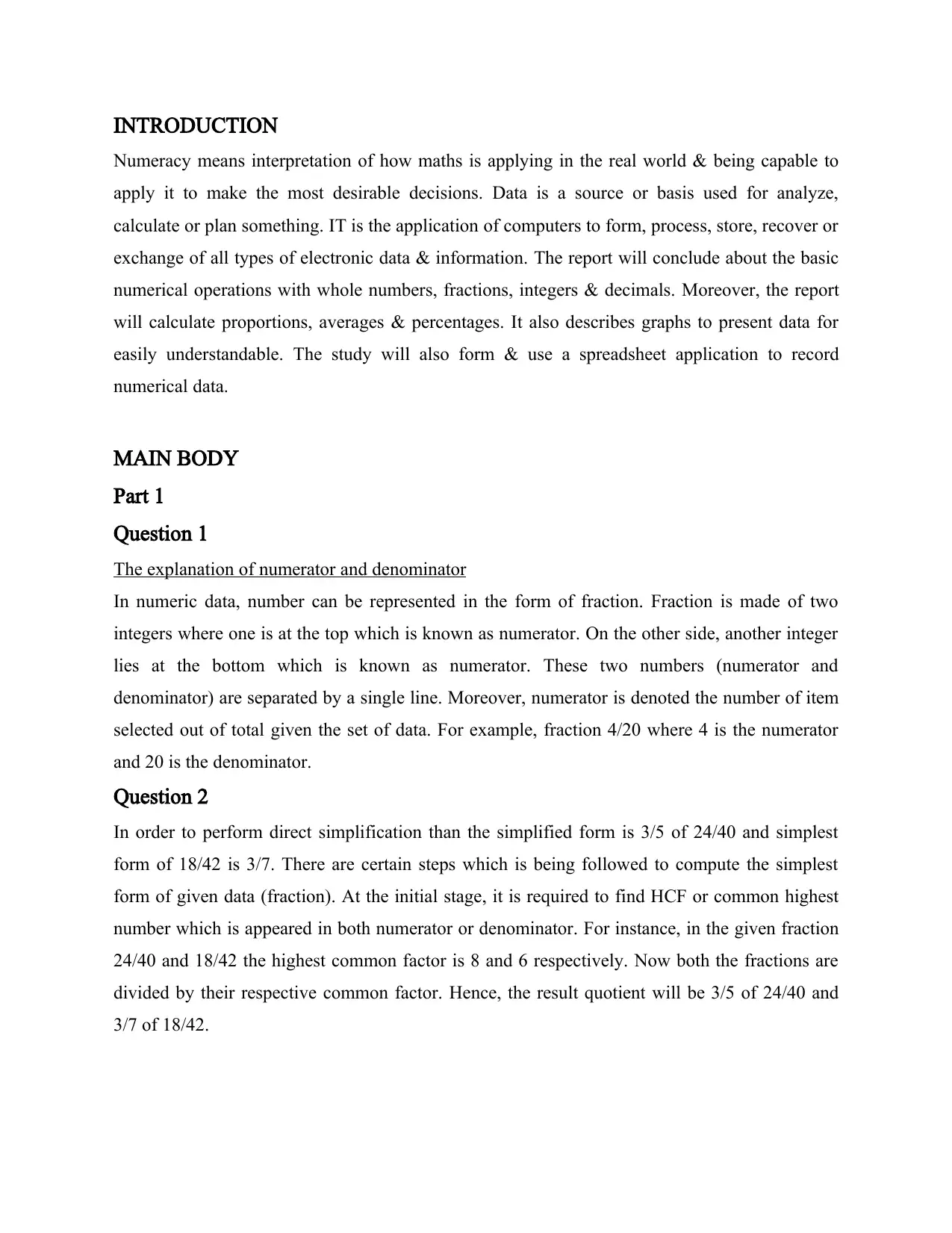
INTRODUCTION
Numeracy means interpretation of how maths is applying in the real world & being capable to
apply it to make the most desirable decisions. Data is a source or basis used for analyze,
calculate or plan something. IT is the application of computers to form, process, store, recover or
exchange of all types of electronic data & information. The report will conclude about the basic
numerical operations with whole numbers, fractions, integers & decimals. Moreover, the report
will calculate proportions, averages & percentages. It also describes graphs to present data for
easily understandable. The study will also form & use a spreadsheet application to record
numerical data.
MAIN BODY
Part 1
Question 1
The explanation of numerator and denominator
In numeric data, number can be represented in the form of fraction. Fraction is made of two
integers where one is at the top which is known as numerator. On the other side, another integer
lies at the bottom which is known as numerator. These two numbers (numerator and
denominator) are separated by a single line. Moreover, numerator is denoted the number of item
selected out of total given the set of data. For example, fraction 4/20 where 4 is the numerator
and 20 is the denominator.
Question 2
In order to perform direct simplification than the simplified form is 3/5 of 24/40 and simplest
form of 18/42 is 3/7. There are certain steps which is being followed to compute the simplest
form of given data (fraction). At the initial stage, it is required to find HCF or common highest
number which is appeared in both numerator or denominator. For instance, in the given fraction
24/40 and 18/42 the highest common factor is 8 and 6 respectively. Now both the fractions are
divided by their respective common factor. Hence, the result quotient will be 3/5 of 24/40 and
3/7 of 18/42.
Numeracy means interpretation of how maths is applying in the real world & being capable to
apply it to make the most desirable decisions. Data is a source or basis used for analyze,
calculate or plan something. IT is the application of computers to form, process, store, recover or
exchange of all types of electronic data & information. The report will conclude about the basic
numerical operations with whole numbers, fractions, integers & decimals. Moreover, the report
will calculate proportions, averages & percentages. It also describes graphs to present data for
easily understandable. The study will also form & use a spreadsheet application to record
numerical data.
MAIN BODY
Part 1
Question 1
The explanation of numerator and denominator
In numeric data, number can be represented in the form of fraction. Fraction is made of two
integers where one is at the top which is known as numerator. On the other side, another integer
lies at the bottom which is known as numerator. These two numbers (numerator and
denominator) are separated by a single line. Moreover, numerator is denoted the number of item
selected out of total given the set of data. For example, fraction 4/20 where 4 is the numerator
and 20 is the denominator.
Question 2
In order to perform direct simplification than the simplified form is 3/5 of 24/40 and simplest
form of 18/42 is 3/7. There are certain steps which is being followed to compute the simplest
form of given data (fraction). At the initial stage, it is required to find HCF or common highest
number which is appeared in both numerator or denominator. For instance, in the given fraction
24/40 and 18/42 the highest common factor is 8 and 6 respectively. Now both the fractions are
divided by their respective common factor. Hence, the result quotient will be 3/5 of 24/40 and
3/7 of 18/42.
Paraphrase This Document
Need a fresh take? Get an instant paraphrase of this document with our AI Paraphraser
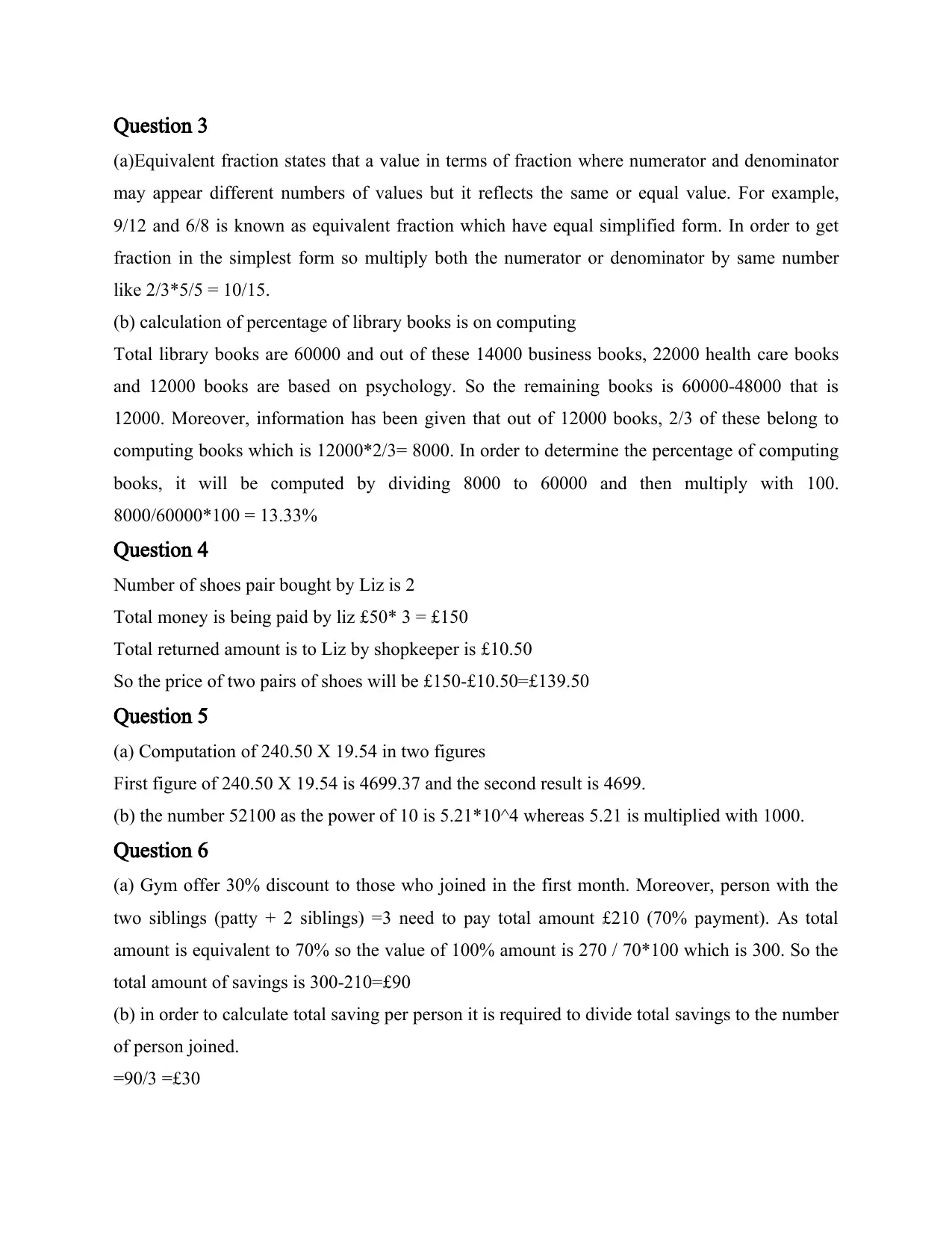
Question 3
(a)Equivalent fraction states that a value in terms of fraction where numerator and denominator
may appear different numbers of values but it reflects the same or equal value. For example,
9/12 and 6/8 is known as equivalent fraction which have equal simplified form. In order to get
fraction in the simplest form so multiply both the numerator or denominator by same number
like 2/3*5/5 = 10/15.
(b) calculation of percentage of library books is on computing
Total library books are 60000 and out of these 14000 business books, 22000 health care books
and 12000 books are based on psychology. So the remaining books is 60000-48000 that is
12000. Moreover, information has been given that out of 12000 books, 2/3 of these belong to
computing books which is 12000*2/3= 8000. In order to determine the percentage of computing
books, it will be computed by dividing 8000 to 60000 and then multiply with 100.
8000/60000*100 = 13.33%
Question 4
Number of shoes pair bought by Liz is 2
Total money is being paid by liz £50* 3 = £150
Total returned amount is to Liz by shopkeeper is £10.50
So the price of two pairs of shoes will be £150-£10.50=£139.50
Question 5
(a) Computation of 240.50 X 19.54 in two figures
First figure of 240.50 X 19.54 is 4699.37 and the second result is 4699.
(b) the number 52100 as the power of 10 is 5.21*10^4 whereas 5.21 is multiplied with 1000.
Question 6
(a) Gym offer 30% discount to those who joined in the first month. Moreover, person with the
two siblings (patty + 2 siblings) =3 need to pay total amount £210 (70% payment). As total
amount is equivalent to 70% so the value of 100% amount is 270 / 70*100 which is 300. So the
total amount of savings is 300-210=£90
(b) in order to calculate total saving per person it is required to divide total savings to the number
of person joined.
=90/3 =£30
(a)Equivalent fraction states that a value in terms of fraction where numerator and denominator
may appear different numbers of values but it reflects the same or equal value. For example,
9/12 and 6/8 is known as equivalent fraction which have equal simplified form. In order to get
fraction in the simplest form so multiply both the numerator or denominator by same number
like 2/3*5/5 = 10/15.
(b) calculation of percentage of library books is on computing
Total library books are 60000 and out of these 14000 business books, 22000 health care books
and 12000 books are based on psychology. So the remaining books is 60000-48000 that is
12000. Moreover, information has been given that out of 12000 books, 2/3 of these belong to
computing books which is 12000*2/3= 8000. In order to determine the percentage of computing
books, it will be computed by dividing 8000 to 60000 and then multiply with 100.
8000/60000*100 = 13.33%
Question 4
Number of shoes pair bought by Liz is 2
Total money is being paid by liz £50* 3 = £150
Total returned amount is to Liz by shopkeeper is £10.50
So the price of two pairs of shoes will be £150-£10.50=£139.50
Question 5
(a) Computation of 240.50 X 19.54 in two figures
First figure of 240.50 X 19.54 is 4699.37 and the second result is 4699.
(b) the number 52100 as the power of 10 is 5.21*10^4 whereas 5.21 is multiplied with 1000.
Question 6
(a) Gym offer 30% discount to those who joined in the first month. Moreover, person with the
two siblings (patty + 2 siblings) =3 need to pay total amount £210 (70% payment). As total
amount is equivalent to 70% so the value of 100% amount is 270 / 70*100 which is 300. So the
total amount of savings is 300-210=£90
(b) in order to calculate total saving per person it is required to divide total savings to the number
of person joined.
=90/3 =£30
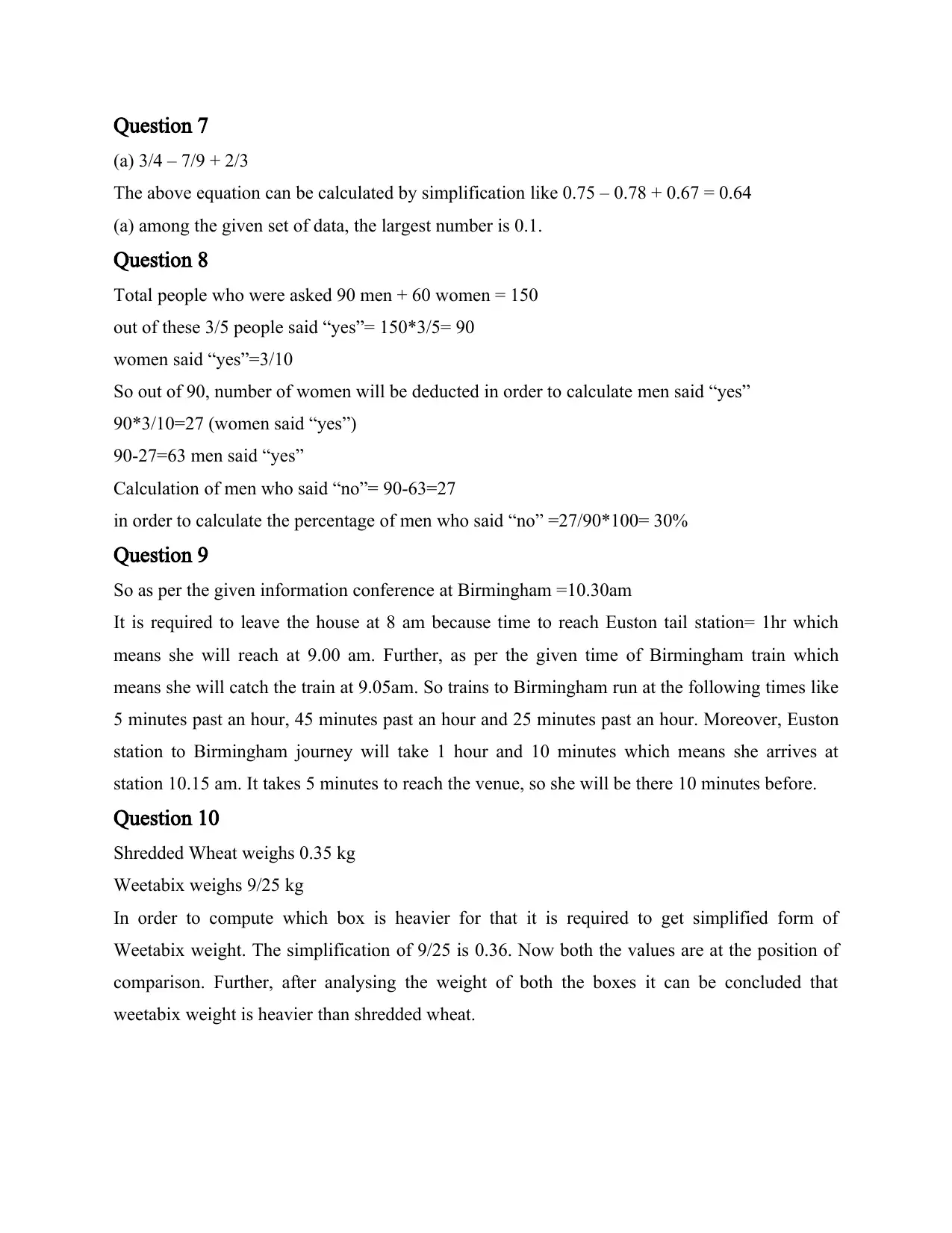
Question 7
(a) 3/4 – 7/9 + 2/3
The above equation can be calculated by simplification like 0.75 – 0.78 + 0.67 = 0.64
(a) among the given set of data, the largest number is 0.1.
Question 8
Total people who were asked 90 men + 60 women = 150
out of these 3/5 people said “yes”= 150*3/5= 90
women said “yes”=3/10
So out of 90, number of women will be deducted in order to calculate men said “yes”
90*3/10=27 (women said “yes”)
90-27=63 men said “yes”
Calculation of men who said “no”= 90-63=27
in order to calculate the percentage of men who said “no” =27/90*100= 30%
Question 9
So as per the given information conference at Birmingham =10.30am
It is required to leave the house at 8 am because time to reach Euston tail station= 1hr which
means she will reach at 9.00 am. Further, as per the given time of Birmingham train which
means she will catch the train at 9.05am. So trains to Birmingham run at the following times like
5 minutes past an hour, 45 minutes past an hour and 25 minutes past an hour. Moreover, Euston
station to Birmingham journey will take 1 hour and 10 minutes which means she arrives at
station 10.15 am. It takes 5 minutes to reach the venue, so she will be there 10 minutes before.
Question 10
Shredded Wheat weighs 0.35 kg
Weetabix weighs 9/25 kg
In order to compute which box is heavier for that it is required to get simplified form of
Weetabix weight. The simplification of 9/25 is 0.36. Now both the values are at the position of
comparison. Further, after analysing the weight of both the boxes it can be concluded that
weetabix weight is heavier than shredded wheat.
(a) 3/4 – 7/9 + 2/3
The above equation can be calculated by simplification like 0.75 – 0.78 + 0.67 = 0.64
(a) among the given set of data, the largest number is 0.1.
Question 8
Total people who were asked 90 men + 60 women = 150
out of these 3/5 people said “yes”= 150*3/5= 90
women said “yes”=3/10
So out of 90, number of women will be deducted in order to calculate men said “yes”
90*3/10=27 (women said “yes”)
90-27=63 men said “yes”
Calculation of men who said “no”= 90-63=27
in order to calculate the percentage of men who said “no” =27/90*100= 30%
Question 9
So as per the given information conference at Birmingham =10.30am
It is required to leave the house at 8 am because time to reach Euston tail station= 1hr which
means she will reach at 9.00 am. Further, as per the given time of Birmingham train which
means she will catch the train at 9.05am. So trains to Birmingham run at the following times like
5 minutes past an hour, 45 minutes past an hour and 25 minutes past an hour. Moreover, Euston
station to Birmingham journey will take 1 hour and 10 minutes which means she arrives at
station 10.15 am. It takes 5 minutes to reach the venue, so she will be there 10 minutes before.
Question 10
Shredded Wheat weighs 0.35 kg
Weetabix weighs 9/25 kg
In order to compute which box is heavier for that it is required to get simplified form of
Weetabix weight. The simplification of 9/25 is 0.36. Now both the values are at the position of
comparison. Further, after analysing the weight of both the boxes it can be concluded that
weetabix weight is heavier than shredded wheat.
⊘ This is a preview!⊘
Do you want full access?
Subscribe today to unlock all pages.

Trusted by 1+ million students worldwide
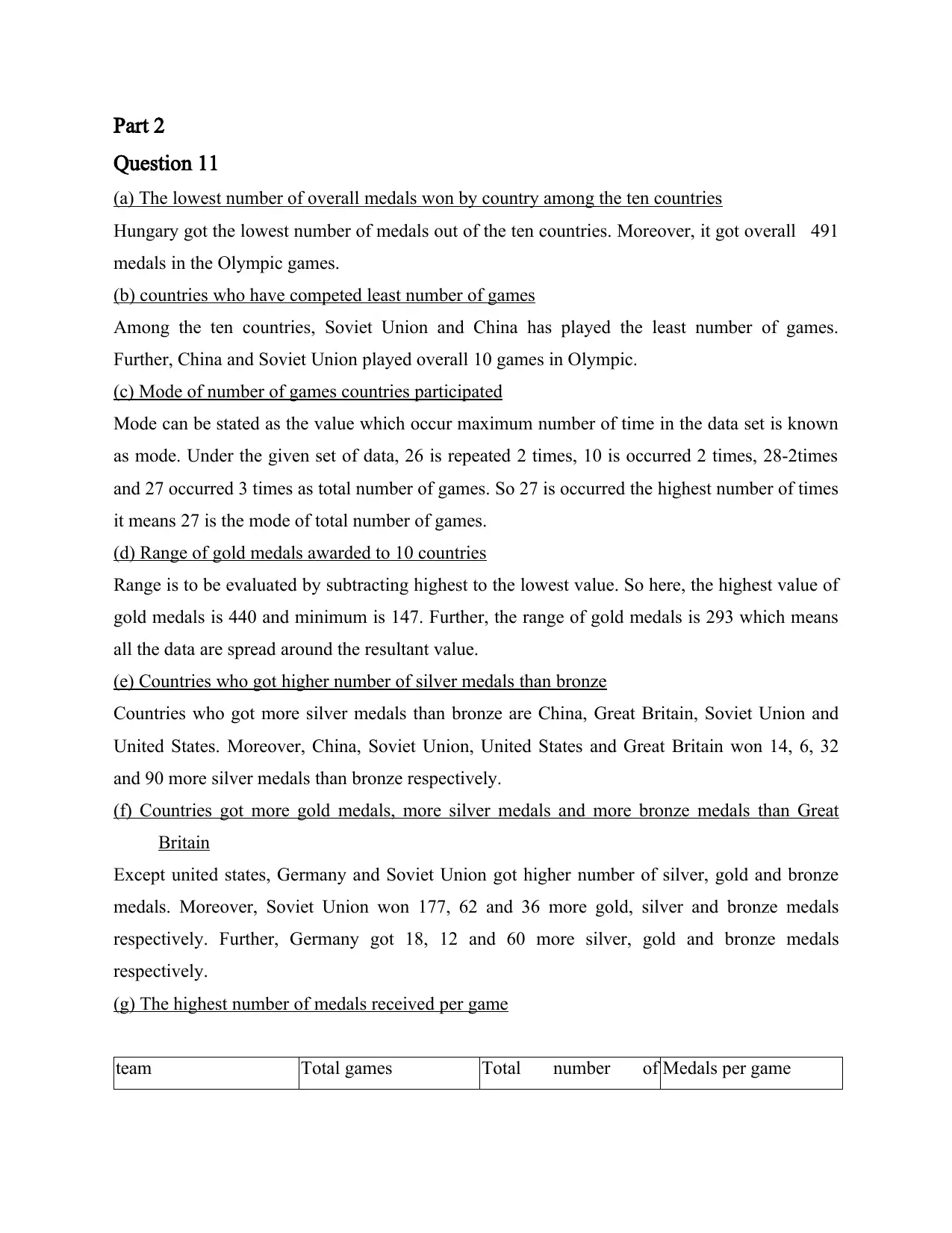
Part 2
Question 11
(a) The lowest number of overall medals won by country among the ten countries
Hungary got the lowest number of medals out of the ten countries. Moreover, it got overall 491
medals in the Olympic games.
(b) countries who have competed least number of games
Among the ten countries, Soviet Union and China has played the least number of games.
Further, China and Soviet Union played overall 10 games in Olympic.
(c) Mode of number of games countries participated
Mode can be stated as the value which occur maximum number of time in the data set is known
as mode. Under the given set of data, 26 is repeated 2 times, 10 is occurred 2 times, 28-2times
and 27 occurred 3 times as total number of games. So 27 is occurred the highest number of times
it means 27 is the mode of total number of games.
(d) Range of gold medals awarded to 10 countries
Range is to be evaluated by subtracting highest to the lowest value. So here, the highest value of
gold medals is 440 and minimum is 147. Further, the range of gold medals is 293 which means
all the data are spread around the resultant value.
(e) Countries who got higher number of silver medals than bronze
Countries who got more silver medals than bronze are China, Great Britain, Soviet Union and
United States. Moreover, China, Soviet Union, United States and Great Britain won 14, 6, 32
and 90 more silver medals than bronze respectively.
(f) Countries got more gold medals, more silver medals and more bronze medals than Great
Britain
Except united states, Germany and Soviet Union got higher number of silver, gold and bronze
medals. Moreover, Soviet Union won 177, 62 and 36 more gold, silver and bronze medals
respectively. Further, Germany got 18, 12 and 60 more silver, gold and bronze medals
respectively.
(g) The highest number of medals received per game
team Total games Total number of Medals per game
Question 11
(a) The lowest number of overall medals won by country among the ten countries
Hungary got the lowest number of medals out of the ten countries. Moreover, it got overall 491
medals in the Olympic games.
(b) countries who have competed least number of games
Among the ten countries, Soviet Union and China has played the least number of games.
Further, China and Soviet Union played overall 10 games in Olympic.
(c) Mode of number of games countries participated
Mode can be stated as the value which occur maximum number of time in the data set is known
as mode. Under the given set of data, 26 is repeated 2 times, 10 is occurred 2 times, 28-2times
and 27 occurred 3 times as total number of games. So 27 is occurred the highest number of times
it means 27 is the mode of total number of games.
(d) Range of gold medals awarded to 10 countries
Range is to be evaluated by subtracting highest to the lowest value. So here, the highest value of
gold medals is 440 and minimum is 147. Further, the range of gold medals is 293 which means
all the data are spread around the resultant value.
(e) Countries who got higher number of silver medals than bronze
Countries who got more silver medals than bronze are China, Great Britain, Soviet Union and
United States. Moreover, China, Soviet Union, United States and Great Britain won 14, 6, 32
and 90 more silver medals than bronze respectively.
(f) Countries got more gold medals, more silver medals and more bronze medals than Great
Britain
Except united states, Germany and Soviet Union got higher number of silver, gold and bronze
medals. Moreover, Soviet Union won 177, 62 and 36 more gold, silver and bronze medals
respectively. Further, Germany got 18, 12 and 60 more silver, gold and bronze medals
respectively.
(g) The highest number of medals received per game
team Total games Total number of Medals per game
Paraphrase This Document
Need a fresh take? Get an instant paraphrase of this document with our AI Paraphraser
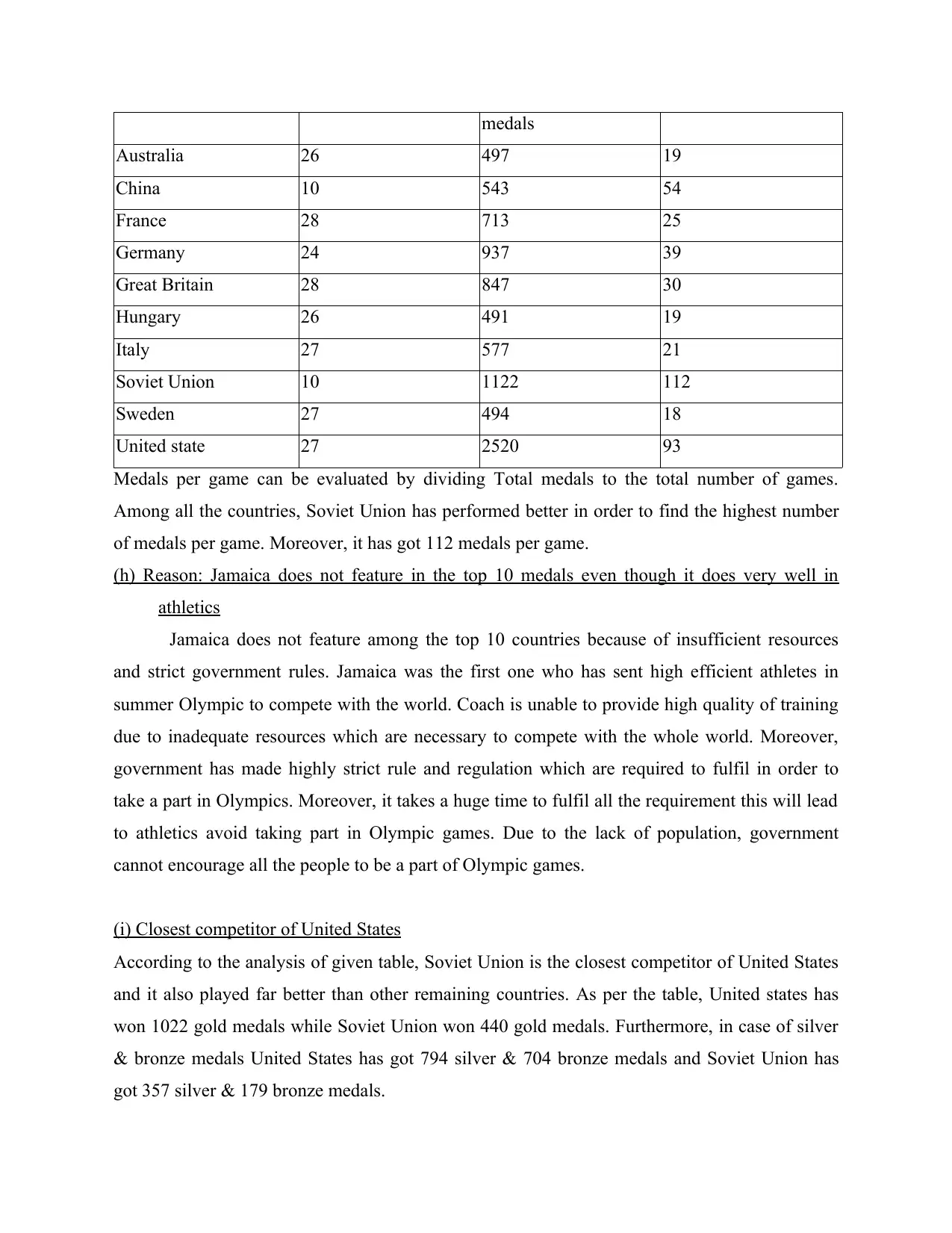
medals
Australia 26 497 19
China 10 543 54
France 28 713 25
Germany 24 937 39
Great Britain 28 847 30
Hungary 26 491 19
Italy 27 577 21
Soviet Union 10 1122 112
Sweden 27 494 18
United state 27 2520 93
Medals per game can be evaluated by dividing Total medals to the total number of games.
Among all the countries, Soviet Union has performed better in order to find the highest number
of medals per game. Moreover, it has got 112 medals per game.
(h) Reason: Jamaica does not feature in the top 10 medals even though it does very well in
athletics
Jamaica does not feature among the top 10 countries because of insufficient resources
and strict government rules. Jamaica was the first one who has sent high efficient athletes in
summer Olympic to compete with the world. Coach is unable to provide high quality of training
due to inadequate resources which are necessary to compete with the whole world. Moreover,
government has made highly strict rule and regulation which are required to fulfil in order to
take a part in Olympics. Moreover, it takes a huge time to fulfil all the requirement this will lead
to athletics avoid taking part in Olympic games. Due to the lack of population, government
cannot encourage all the people to be a part of Olympic games.
(i) Closest competitor of United States
According to the analysis of given table, Soviet Union is the closest competitor of United States
and it also played far better than other remaining countries. As per the table, United states has
won 1022 gold medals while Soviet Union won 440 gold medals. Furthermore, in case of silver
& bronze medals United States has got 794 silver & 704 bronze medals and Soviet Union has
got 357 silver & 179 bronze medals.
Australia 26 497 19
China 10 543 54
France 28 713 25
Germany 24 937 39
Great Britain 28 847 30
Hungary 26 491 19
Italy 27 577 21
Soviet Union 10 1122 112
Sweden 27 494 18
United state 27 2520 93
Medals per game can be evaluated by dividing Total medals to the total number of games.
Among all the countries, Soviet Union has performed better in order to find the highest number
of medals per game. Moreover, it has got 112 medals per game.
(h) Reason: Jamaica does not feature in the top 10 medals even though it does very well in
athletics
Jamaica does not feature among the top 10 countries because of insufficient resources
and strict government rules. Jamaica was the first one who has sent high efficient athletes in
summer Olympic to compete with the world. Coach is unable to provide high quality of training
due to inadequate resources which are necessary to compete with the whole world. Moreover,
government has made highly strict rule and regulation which are required to fulfil in order to
take a part in Olympics. Moreover, it takes a huge time to fulfil all the requirement this will lead
to athletics avoid taking part in Olympic games. Due to the lack of population, government
cannot encourage all the people to be a part of Olympic games.
(i) Closest competitor of United States
According to the analysis of given table, Soviet Union is the closest competitor of United States
and it also played far better than other remaining countries. As per the table, United states has
won 1022 gold medals while Soviet Union won 440 gold medals. Furthermore, in case of silver
& bronze medals United States has got 794 silver & 704 bronze medals and Soviet Union has
got 357 silver & 179 bronze medals.
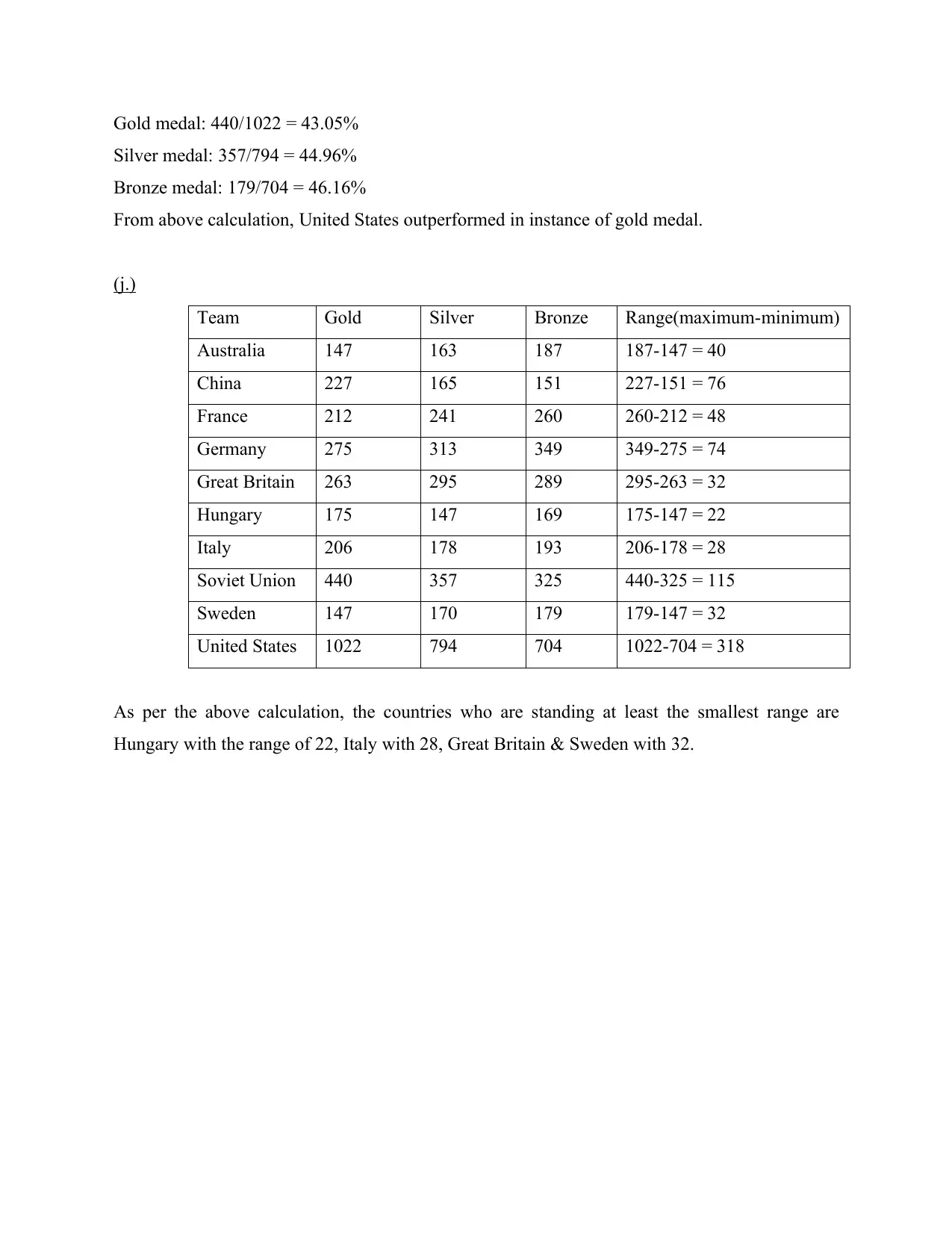
Gold medal: 440/1022 = 43.05%
Silver medal: 357/794 = 44.96%
Bronze medal: 179/704 = 46.16%
From above calculation, United States outperformed in instance of gold medal.
(j.)
Team Gold Silver Bronze Range(maximum-minimum)
Australia 147 163 187 187-147 = 40
China 227 165 151 227-151 = 76
France 212 241 260 260-212 = 48
Germany 275 313 349 349-275 = 74
Great Britain 263 295 289 295-263 = 32
Hungary 175 147 169 175-147 = 22
Italy 206 178 193 206-178 = 28
Soviet Union 440 357 325 440-325 = 115
Sweden 147 170 179 179-147 = 32
United States 1022 794 704 1022-704 = 318
As per the above calculation, the countries who are standing at least the smallest range are
Hungary with the range of 22, Italy with 28, Great Britain & Sweden with 32.
Silver medal: 357/794 = 44.96%
Bronze medal: 179/704 = 46.16%
From above calculation, United States outperformed in instance of gold medal.
(j.)
Team Gold Silver Bronze Range(maximum-minimum)
Australia 147 163 187 187-147 = 40
China 227 165 151 227-151 = 76
France 212 241 260 260-212 = 48
Germany 275 313 349 349-275 = 74
Great Britain 263 295 289 295-263 = 32
Hungary 175 147 169 175-147 = 22
Italy 206 178 193 206-178 = 28
Soviet Union 440 357 325 440-325 = 115
Sweden 147 170 179 179-147 = 32
United States 1022 794 704 1022-704 = 318
As per the above calculation, the countries who are standing at least the smallest range are
Hungary with the range of 22, Italy with 28, Great Britain & Sweden with 32.
⊘ This is a preview!⊘
Do you want full access?
Subscribe today to unlock all pages.

Trusted by 1+ million students worldwide
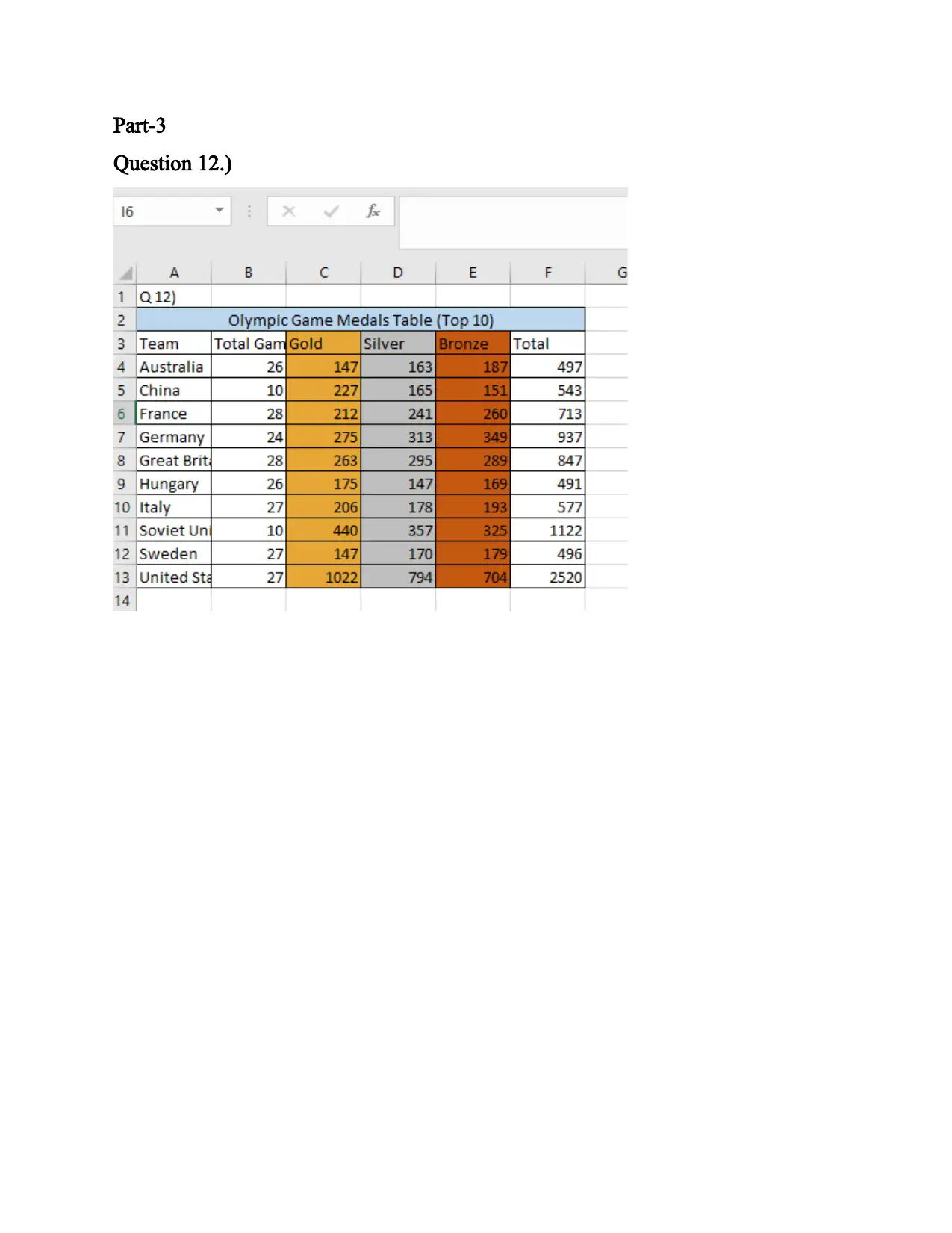
Part-3
Question 12.)
Question 12.)
Paraphrase This Document
Need a fresh take? Get an instant paraphrase of this document with our AI Paraphraser
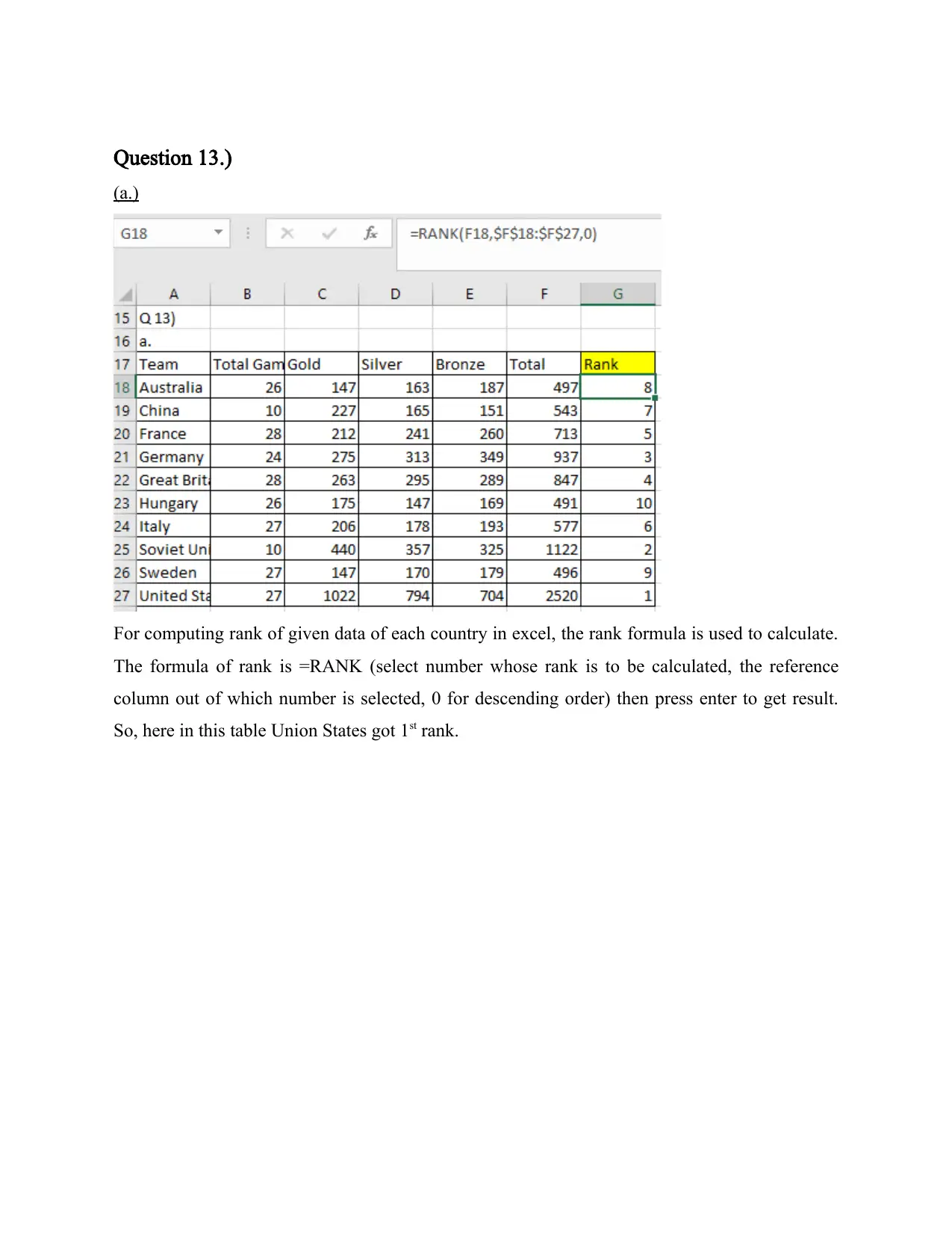
Question 13.)
(a.)
For computing rank of given data of each country in excel, the rank formula is used to calculate.
The formula of rank is =RANK (select number whose rank is to be calculated, the reference
column out of which number is selected, 0 for descending order) then press enter to get result.
So, here in this table Union States got 1st rank.
(a.)
For computing rank of given data of each country in excel, the rank formula is used to calculate.
The formula of rank is =RANK (select number whose rank is to be calculated, the reference
column out of which number is selected, 0 for descending order) then press enter to get result.
So, here in this table Union States got 1st rank.
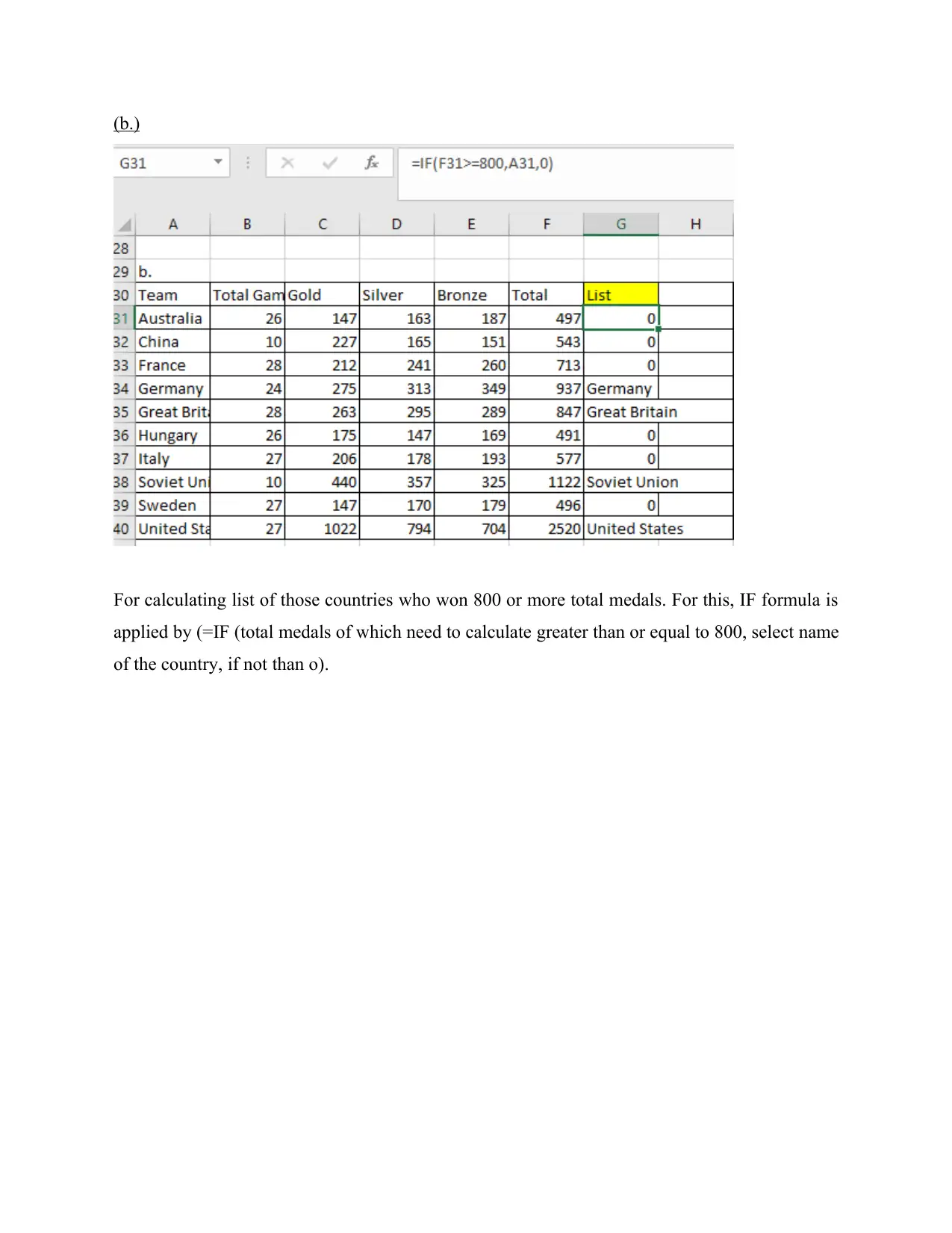
(b.)
For calculating list of those countries who won 800 or more total medals. For this, IF formula is
applied by (=IF (total medals of which need to calculate greater than or equal to 800, select name
of the country, if not than o).
For calculating list of those countries who won 800 or more total medals. For this, IF formula is
applied by (=IF (total medals of which need to calculate greater than or equal to 800, select name
of the country, if not than o).
⊘ This is a preview!⊘
Do you want full access?
Subscribe today to unlock all pages.

Trusted by 1+ million students worldwide
1 out of 22
Related Documents
Your All-in-One AI-Powered Toolkit for Academic Success.
+13062052269
info@desklib.com
Available 24*7 on WhatsApp / Email
![[object Object]](/_next/static/media/star-bottom.7253800d.svg)
Unlock your academic potential
Copyright © 2020–2025 A2Z Services. All Rights Reserved. Developed and managed by ZUCOL.





